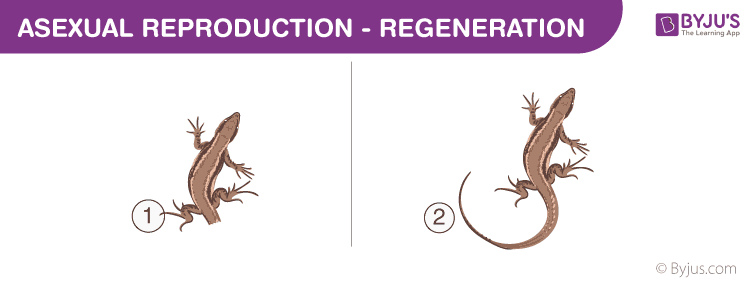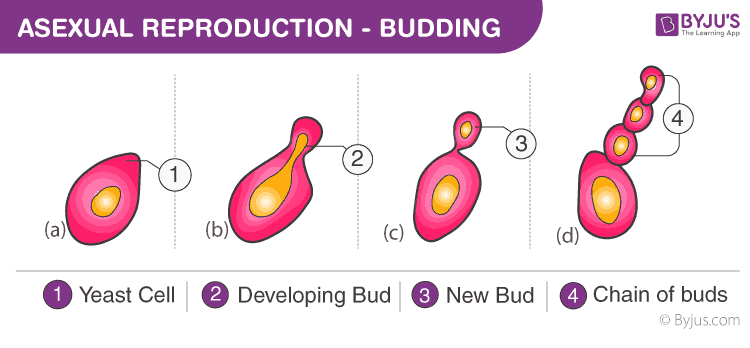3 Advantages Of Asexual Reproduction
Table of Contents
- What is Asexual Reproduction?
- Characteristics of Asexual Reproduction
- Types of Asexual Reproduction
- Advantages of Asexual Reproduction
- Disadvantages of Asexual Reproduction
- Asexual Reproduction Examples
Asexual Reproduction Definition
"Asexual reproduction is the mode of reproduction that is involved in the production of offspring by a single parent."
What is Asexual Reproduction?
Asexual reproduction is a mode of reproduction in which a new offspring is produced by a unmarried parent. The new individuals produced are genetically and physically identical to each other, i.e., they are the clones of their parents.
Asexual reproduction is observed in both multicellular and unicellular organisms. This process does not involve whatsoever kind of gamete fusion and at that place won't be whatsoever alter in the number of chromosomes either. It volition inherit the same genes as the parent, except for some cases where there is a chance of a rare mutation occurring.
Also Read:Reproduction
Characteristics of Asexual Reproduction
Following are the of import features of asexual reproduction:
- Single parent involved.
- No fertilization or gamete formation takes place.
- This process of reproduction occurs in a very short time.
- The organisms multiply and grow rapidly.
- The offspring is genetically similar.
Types of Asexual Reproduction
There are different types of asexual reproduction:
- Binary Fission
- Budding
- Fragmentation
- Vegetative Propagation
- Sporogenesis
Binary Fission
The term "fission" means "to divide". During binary fission, the parent cell divides into 2 cells. The cell segmentation patterns vary in different organisms, i.e., some are directional while others are non-directional. Amoeba and euglena exhibit binary fission.
It is one of the simplest and uncomplicated methods of asexual reproduction. The parent cell divides into two, each girl cell carrying a nucleus of its own that is genetically identical to the parent. The cytoplasm as well divides leading to two equal-sized daughter cells. The process repeats itself and the daughter cells abound and further dissever.
Fragmentation
Fragmentation is some other fashion of asexual reproduction exhibited by organisms such as spirogyra, planaria etc. The parent trunk divides into several fragments and each fragment develops into a new organism.

Too Read: Fragmentation
Regeneration
Regeneration is the ability of growing a new organism from the lost trunk part. For eg., when a lizard loses its tail, a new tail grows. This is because the specialized cells nowadays in the organism can differentiate and abound into a new individual. Organisms similar hydra and planaria showroom regeneration.

Budding
Budding is the process of producing an individual through the buds that develop on the parent body. Hydra is an organism that reproduces by budding. The bud derives diet and shelter from the parent organism and detaches once it is fully grown.

For More Information On Budding, Spotter The Beneath Video:

Vegetative Propagation
Asexual reproduction in plants occurs through their vegetative parts such as leaves, roots, stems, and buds. This is called vegetative propagation. For example, potato tubers, runners/stolon, onion bulbs, etc., all reproduce through vegetative propagation.
Spore Germination
Spore formation is some other means of asexual reproduction. During unfavourable atmospheric condition, the organism develops sac-like structures called sporangium that incorporate spores. When the weather condition are favourable, the sporangium burst opens and spores are released that germinate to give rise to new organisms.

In asexual reproduction, a single cell is divided to produce offspring. Uncomplicated cell-by-jail cell division is non possible in multicellular organisms. Nearly of the multicellular organisms accept a circuitous body design. They have a higher level of arrangement similar tissues, organs and organ systems. Thus, they demand a special mode for reproduction.
Besides Read: Modes of Reproduction
Recommended Videos:


Advantages of Asexual Reproduction
Following are the advantages of asexual reproduction:
- Mates are non required.
- The process of reproduction is rapid.
- An enormous number of organisms can be produced in very less time.
- Positive genetic influences pass on to successive generations.
- Information technology occurs in various environments.
Disadvantages of Asexual Reproduction
The major disadvantages of asexual reproduction are:
- Lack of diverseness. Since the offsprings are genetically identical to the parent they are more than susceptible to the same diseases and nutrient deficiencies every bit the parent. All the negative mutations persist for generations.
- Since simply one organism is involved, the variety amid the organisms is express.
- They are unable to accommodate to the changing environment.
- A single change in the surroundings would eliminate the entire species.
Asexual Reproduction Examples
Following are the examples of asexual reproduction:
- Bacterium undergoes binary fission in which the cell divides into ii along with the nucleus.
- Blackworms or mud worms reproduce through fragmentation.
- Hydras reproduce through budding.
- Organisms such every bit copperheads undergo parthenogenesis.
- Sugarcane can be grown through vegetative propagation.
Too Read: Sexual Reproduction
For more detailed information on asexual reproduction, its types, advantages and disadvantages, examples go along visiting BYJU'Due south website or download BYJU'Due south app for further reference.
Ofttimes Asked Questions
What is asexual reproduction?
Asexual reproduction is a style of reproduction in which only ane parent is involved to reproduce offspring. In asexual reproduction, the offsprings produced are exact copies of their parents. It is more often than not observed in very small-sized organisms.
What is the departure betwixt sexual reproduction and asexual reproduction?
| Sexual | Asexual |
| Two parents accept part | Single parent |
| Variation occurs in offspring | Offspring are genetically identical to each other and to their parent |
| Fertilization takes place | No Internal fertilization or External fertilization |
| Gametes are involved | No gametes |
| Mixing of hereditary material | No mixing of hereditary fabric |
How sexual reproduction is advantageous over asexual reproduction?
Sexual reproduction brings variations in the population. When gametes (reproductive cells) from two individuals meet, genes from two individuals are coming together. So the offspring volition be dissimilar from both parents. That is how more variety can be seen in the offspring in sexual reproduction.
Diversity is of import for the population to adapt to any alter in the surroundings.
Asexual reproduction produces carbon copies of individuals. Variety is not seen in populations. So they cant adapt well if changes occur in a population.
Justify the statement 'Vegetative reproduction is also a type of asexual reproduction.
The formation of new plants from the vegetative parts of the establish called vegetative propagules is chosen vegetative propagation or reproduction.
Vegetative propagation tin exist considered asexual reproduction because of the post-obit reasons:-
- Only ane parent is involved.
- It doesn't involve meiosis and fusion of gametes.
- The offspring are genetically like to the parents.
What are the advantages of asexual reproduction?
The advantages of asexual reproduction are post-obit:
- Rapid Populating: Asexual reproduction gives the ability to produce large quantities of offspring.
- No Mates Required: Asexual reproduction takes the demand to detect a mate abroad, allowing these organisms to multiply.
- In Case of Emergency: In dire situations, plants and organisms tin continue themselves alive and produce others to aid them without the help of a mate, or other reproductive sources. Plants are a corking instance of this. If no pollinator is available to pollinate, then they can clone by asexual reproduction.
- No True Investment: Asexual reproducers do not have to carry their offspring for a long amount of time and produce more than i at a time. This makes it a quick and inexpensive procedure for them in the terms of time.
Recommended Video:

3 Advantages Of Asexual Reproduction,
Source: https://byjus.com/biology/asexual-reproduction/
Posted by: gordonfastir.blogspot.com


0 Response to "3 Advantages Of Asexual Reproduction"
Post a Comment